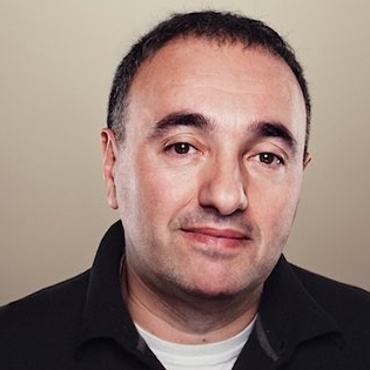Žūrija 2008
Konkursa programma

Aleksandrs Rodņanskis — film director, film producer, television executive and businessman. Member of The Academy of Motion Picture Arts and Sciences.Rodnyansky was born in Kyiv to Jewish parents, both of whom worked at the Ukrainian film studio Kontakt. His father Yefim Fridman was a senior engineer, while his mother Larisa Rodnyanskaya served as a film producer. Alexander's maternal grandfather Zinovy Rodnyansky worked on documentary films as a screenwriter and editor, and so did his cousin Esfir Shub — a prominent Soviet director.Alexander's cousin Boris Fuchsmann is a German media mogul and investor, as well as a vice-president of the World Jewish Congress and a president of Jewish Confederation of Ukraine. Together they co-founded the 1+1 TV Channel and built the Hilton Kyiv.During his career, Rodnyansky produced over 30 films and more than 20 television series including Stalingrad (2013) - the highest grossing Russian film ever ($67 million).[9] Among other films produced by Rodnyansky: The 9th Company (2005), Heat (2006), Piter FM (2006), The Inhabited Island (2009), The Sun (2005), A Chef in Love (1997), A Driver for Vera (2004), East/West (1999). He created Ukrainian TV network 1+1 and for seven years was the CEO of Russian media company CTC Media.Alexander Rodnyansky graduated from Kyiv's National University of Film, Theatre and Television as a documentary director. In 1983 he started his career at Kyivnaukfilm studio. He has directed 10 feature documentaries which won him over 40 prestigious awards both at home and abroad. For the documentary Raoul Wallenberg’s Mission he was awarded the highest award for a documentary filmmaker in the USSR – the Russian National Film Award NIKA as well as the European Film Award (for Best Documentary).

Tatjana Drubiča — по праву считается самой интелигентной актрисой Российского кино. Однако, кинокарьера, по словам самой актрисы, - цепь случайных совпадений, которых могло не быть. В возрасте 13 лет она снялась в героико-приключенческом фильме Инны Туманян «Пятнадцатая весна», так состоялся дебют Татьяны в кино. Вторым фильмом стала лента Сергея Соловьева «Сто дней после детства», которая снималась в 1975 году. Не смотря на две успешные роли в кино, Татьяна отказалась поступать во ВГИК, где ее ждали, а закончила вечерний факультет Московского медицинского стоматологического института им. Семашко и стала работать врачом в районной поликлинике. В то же время Татьяна изредка снимается в кино и все чаще попадает на обложку журнала «Советский экран». После не слишком удачной роли у Павла Арсенова в «Смятении чувств», Татьяна Друбич вновь оказалась на съемочной площадке у Соловьева, ставившего «Спасателя». Эта лента не осталась незамеченной, и вскоре последовали новые совместные работы Соловьева и Друбич. В конце 1980-х годов Татьяна Друбич исполнила главные роли в знаменитых фильмах «Асса» и «Черная роза — эмблема печали, красная роза — эмблема любви». В арсенале актрисы и другие интересные работы: у Романа Балаяна в картине «Храни меня, мой талисман», у Станислава Говорухина в экранизации детективного романа Агаты Кристи «Десять негритят» и у Эльдара Рязанова в комедии «Привет, дуралеи!», в драме Александра Зельдовича «Москва».

Oļegs Kuļiks — was born in Kiev, graduated from Kiev Art School (1979) and Kiev Geological Survey College (1982), and was awarded a scholarship by the Berlin Senate in 1996. He lives and works in Moscow.For his performances, Kulik creates a symbolic set of parameters to define the environment which he will inhabit in the persona of a dog, and then devises a series of actions that unfold as a response. The artist describes the dialogue within his practice as "a conscious falling out of the human horizon" which places him on hands and knees. His intention is to describe what he sees as a crisis of contemporary culture, a result of an overly refined cultural language which creates barriers between individuals. Thus, he simplifies his performance language to half of the basic emotional vocabulary of a domestic animal.In 2007 "Oleg Kulik: Chronicle 1987–2007, a retrospective of Kulik's work, was exhibited at the Central House of Artists, Moscow. It was also exhibited at Rencontres d'Arles festival, France in 2004.As curator of the Regina Gallery, Kulik became known for his unorthodox approaches such as putting paintings on wheels and hiring people to carry the artworks.Kulik considers his best curatorial endeavor to be "Leopards Bursting into a Temple" by Anatoly Osmolovsky in 1992. In this exhibit, two naked people were put into a cell with live leopards walking around them. He had said that he thought the exhibition was a "metaphor for everything new and lively that appears in our life".[4]In 2009, Kulik curated the "Kandinsky Prize in London" at the Louise Blouin Foundation.[4]